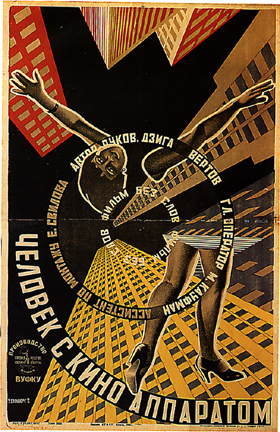|

(1929, directed by Dziga Vertov)
- inducted 2013 -
"In 1929, Dziga Vertov conducted a little experiment. Seeking to create what he expressed
as, 'a truly international language of cinema, based on its absolute separation from the language of theater and literature,'
he and his brother, Mikhail Kaufman, turned a 'kino-eye' on the Ukrainian cities of Odessa, Kharkiv, and Kiev, shooting footage
of just about anything that caught their eye, or sparked their imagination. Once filming was complete, Vertov and his wife
Elizaveta Svilova retired to the editing room and began collating clips into small, contextually labeled canisters (e.g.,
'People,' 'The Plant,' 'The Bazaar,' 'Magician,' 'Machinery,' etc.). Once the menagerie was catalogued, the scissors came
out, theory was put into practice, and the rest, as they say, is history.
"Man With a Movie Camera is, first and foremost, a documentary; a snapshot of life in a Soviet city. It begins at dawn,
tracking the gradual awakenings of the city and its inhabitants as they emerge from slumber and trickle into the environs
and engines of everyday life. It ends, as most days do, with the gradual slowdown of the day's activities, as machines go
idle and the people set aside their labors to indulge in a litle rest and relaxation. As documentaries go, pretty standard
stuff.
"Where Vertov's film differs, however, is in how he presented these images to the movie-going public. The film is not just
a documentary of place, but also an essay on the art of cinema itself. As mentioned above, Vertov referred to his camera as
his 'kino eye;' a mechanical extension of his physical/mental self, thus capable of capturing the essence of humanity and
storing it like a ghost within the machine. Just as the human brain records and recalls experience, so, too, does the camera,
and, with that idea in mind, he and his wife set about assembling their film in a way that reflected the rapid-fire reportage
of human thought. Their goal was to see if cinema, like memory, was capable of supplying significance sans structure, wherein
creative editing could achieve that delicate alchemy where an image alone fuses with the mind of the viewer to engender empathy,
acknowledgement, and understanding.
"And so, Vertov's film hits the viewer's eye like a shot gun blast, peppering the mind with wave after wave of seemingly disconnected
images that imprint not only an impression of people, places, and things, but the idea of a city itself; its soul,
if you will. Images wash over you like water, and their significance and meaning slowly seep into your subconscious. Your
thoughts and memories begin to intertwine with the visual display, and you begin to relate to these lives as keenly
as your own. And suddenly, you realize that humanity has indeed been harnessed by Vertov's machine, and that you, the viewer,
have become symbiotically and psychologically linked to his subjects. Your combined experiences influence and define each
other, and you become one consciousness adrift on the ocean of being. The past becomes present, and all lives interconnect.
"So was the experiment sucessful? Most definitely. (You wouldn't be reading this if it weren't). Man With a Movie Camera
is a tour-de-force of technical proficiency, incorporating filming and editing techniques that are hallmarks of past, present,
and what would become the future of cinematic artistry. Its innovative use of non-linear narrative is both groundbreaking
and intellectually sublime. But it is in the way Dziga Vertov utilized these proficiencies that he achieves his thesis, and
thus, leaves an indelible stamp upon the history of film."
~ Donald G. Carder
Original title: Chelovek s kino-apparatom
Principal cast: Mikhail Kaufman
Scenario by Dziga Vertov
Director of photography: Mikhail Kaufman, Gleb Troyanski (uncredited)
Film editing by Dziga Vertov, Yelizaveta Svilova (assistant editor)
Original music by Konstantin Listov
Music for reissues written by Pierre Henry, Nigel Humberstone, Michael Nyman
USSR
Duration: 68 minutes
Languages: Silent
Filmed in black and white
Sound mix: Silent
Aspect ratio: 1.33:1
Produced by VUFKU
Released in USA by Amkino Corporation
Premiered in Kiev, Ukraine, USSR on 8 January 1929
USA release date: 12 May 1929
Awards and honors:
- Selected as one of Roger Ebert’s “Great Movies,” 1 July 2009
|

